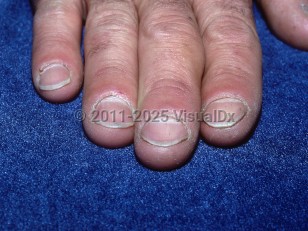Thoracic outlet syndrome
Alerts and Notices
Important News & Links
Synopsis
Thoracic outlet syndrome (TOS) describes a set of progressive symptoms caused by compression of the brachial plexus and/or subclavian vessels between the first rib and clavicle. Its incidence in the United States ranges from 3-80 cases per 1000 people, and it usually occurs between the ages of 20 and 50 years.
TOS is classified as neurogenic, venous, or arterial depending on the predominantly affected structure. Compression of the brachial plexus (neurogenic) accounts for about 95% of cases and affects women 3-4 times more often than men. It presents variably as pain, weakness, tingling, or numbness from the neck to hand, corresponding to the level of nerve compression.
Venous compression accounts for 4% of cases and presents as upper extremity swelling, cyanosis, vein distension, and diffuse deep pain. Thrombosis is often reported. Arterial compression accounts for less than 1% of cases and presents as pain, numbness, coolness, and pallor of the arm and hand that worsens in colder temperatures, with possible distal ischemia. Venous and arterial compression affect men and women equally but may be more common in athletic male patients than in female patients.
The syndrome can arise from a number of conditions, including a congenital anatomic abnormality, a traumatic injury, and repetitive or strenuous motions. Anomalous structures including bones, inflamed / hypertrophic muscles, fibrous bands, tumors, or obstructions within the thoracic outlet region may cause compression. Risk factors include repetitive overhead arm movements (eg, swimming, pitching, heavy overhead lifting, racket sports) and hypercoagulable states. Descent of the shoulder girdle and postural changes such as sagging musculature associated with aging, obesity, or heavy breasts can also predispose patients to TOS. Loosening of joints associated with pregnancy can also be a factor.
TOS is classified as neurogenic, venous, or arterial depending on the predominantly affected structure. Compression of the brachial plexus (neurogenic) accounts for about 95% of cases and affects women 3-4 times more often than men. It presents variably as pain, weakness, tingling, or numbness from the neck to hand, corresponding to the level of nerve compression.
Venous compression accounts for 4% of cases and presents as upper extremity swelling, cyanosis, vein distension, and diffuse deep pain. Thrombosis is often reported. Arterial compression accounts for less than 1% of cases and presents as pain, numbness, coolness, and pallor of the arm and hand that worsens in colder temperatures, with possible distal ischemia. Venous and arterial compression affect men and women equally but may be more common in athletic male patients than in female patients.
The syndrome can arise from a number of conditions, including a congenital anatomic abnormality, a traumatic injury, and repetitive or strenuous motions. Anomalous structures including bones, inflamed / hypertrophic muscles, fibrous bands, tumors, or obstructions within the thoracic outlet region may cause compression. Risk factors include repetitive overhead arm movements (eg, swimming, pitching, heavy overhead lifting, racket sports) and hypercoagulable states. Descent of the shoulder girdle and postural changes such as sagging musculature associated with aging, obesity, or heavy breasts can also predispose patients to TOS. Loosening of joints associated with pregnancy can also be a factor.
Codes
ICD10CM:
G54.0 – Brachial plexus disorders
SNOMEDCT:
128210009 – Thoracic outlet syndrome
G54.0 – Brachial plexus disorders
SNOMEDCT:
128210009 – Thoracic outlet syndrome
Look For
Subscription Required
Diagnostic Pearls
Subscription Required
Differential Diagnosis & Pitfalls

To perform a comparison, select diagnoses from the classic differential
Subscription Required
Best Tests
Subscription Required
Management Pearls
Subscription Required
Therapy
Subscription Required
References
Subscription Required
Last Reviewed:08/10/2020
Last Updated:04/30/2024
Last Updated:04/30/2024
Thoracic outlet syndrome

